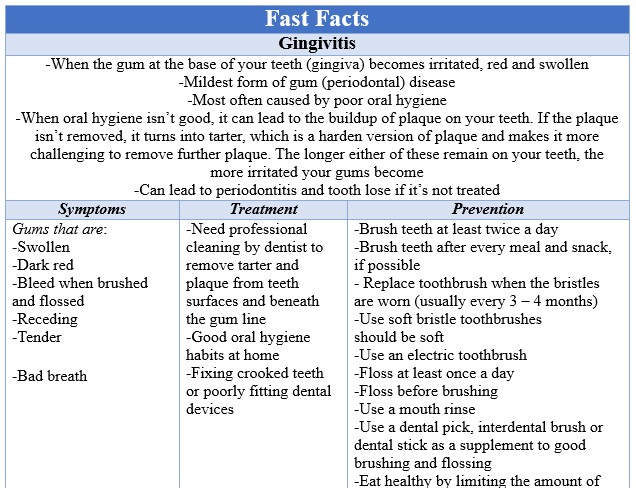What’s causing your gums to bleed?
One evening before you go to bed, you’re brushing your teeth and notice that your gums start bleeding. You rinse your mouth and it stops. The next morning, the same thing happens. What’s causing this? Are you brushing too hard or is it something else? What can you do to fix it?
%20TN.jpg) Definition
Definition
Gingivitis is when the part of your gum that is at the base of your teeth (gingiva) becomes irritated, red and swollen. It’s the mildest form of gum (periodontal) disease and is most often caused by poor oral hygiene. When your oral hygiene isn’t good, it can lead to the buildup of plaque on your teeth. Plaque is typically invisible and is the result of starches and sugars in the foods that you eat interacting with the bacteria that is normally in your mouth. If the plaque isn’t removed, it turns into tarter, which is a harden version of plaque and makes it more challenging to remove further plaque. The longer either of these remain on your teeth, the more irritated your gums become. The buildup of tarter and plaque also makes it easy for cavities to form and can lead to periodontitis and tooth loss if it’s not treated.
The most common symptoms of gingivitis are gums that are swollen, dark red, bleed when you brush and floss, receding and/or tender. Bad breath is also a sign. Besides having poor oral hygiene, some other risk factors include smoking/chewing tobacco, dry mouth, older age, poor nutrition (especially vitamin C deficiency), crooked teeth/poor fitting dental devices that make it difficulty to clean your teeth, genetics, hormonal changes (pregnancy, menopause), conditions that decrease your immune system’s capabilities (cancer, HIV/AIDS), certain infections or certain types of medications.
Treatment
It’s critical to seek care for gingivitis at the first sign of it because it can lead to serious complications that can result in the loss of teeth if it’s not treated early. There is also concern that if the bacteria from gingivitis enters your bloodstream, it can cause infections elsewhere in your body. If you have gingivitis, your dentist will need to remove tarter and plaque through a procedure called scaling and root planning. Scaling is when they use their instruments to remove tarter from the surfaces of your teeth and beneath the gums. Root planning is used to remove the bacteria caused by inflammation. By doing this, your dentist is able to smooth the root surface, which hinders further buildup of plaque and tarter allowing for your gums to heal. After having this done, it’s essential that you practice good oral hygiene habits at home in order to encourage healing. If you’re having trouble cleaning your teeth due to your teeth being crooked or having poorly fitting dental devices, your dentist can offer recommendations as to what you should do to correct this so you can prevent gingivitis from occurring. As far as what you should be doing to have good oral hygiene, please see the Prevention section because it’s the same steps.
Prevention
The best way to prevent gingivitis is by having good oral hygiene. The most important thing you should be doing is brushing your teeth at least twice a day in order to remove plaque because it accumulates quickly. If you are able to brush your teeth after every meal and snack, that’s even better. Some considerations about your toothbrush are that it should be replaced when the bristles are worn, which is usually every 3 – 4 months, the bristles should be soft and some individuals find that electric toothbrushes are more effective at removing plaque. Just as important as brushing is flossing. You should do this at least once a day and it’s better to do this before you brush. Using a mouth rinse is also helpful to reduce the amount of plaque between your teeth. Another useful tool to have is a dental pick, interdental brush or dental stick because they are intended to clean between your teeth. These are great as a supplement to good brushing and flossing, but shouldn’t be used as a replacement. Also, it’s important to eat healthy by limiting the amount of foods and drinks that you consume that are high in sugar. Not smoking or chewing tobacco is also key for having healthy teeth and gums. Besides doing all of these steps, you should get regularly cleanings by your dentist or dental hygienist every 6 – 12 months. Having X-rays once a year allows your dentist to see any changes that they can’t visualize during an examination. Occasionally, if you have risk factors that increase your chances of developing gingivitis, your dentist might recommend that you have professional cleanings more frequently.
Gingivitis is your body’s way of letting you know that you need to take better care of your mouth before something more serious occurs. The good news is that with prompt treatment, it goes away fairly quickly. If you have any questions or concerns about gingivitis, please speak with your dentist. If you would like more information, please visit the American Dental Association (ADA) gingivitis page at https://www.mouthhealthy.org/en/az-topics/g/gingivitis